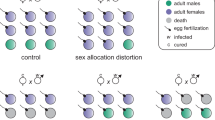Abstract
FEMALE-BIASED sex ratios are predicted under local mate competition where offspring of one or a few females mate in isolated subpopulations1. Haplodiploid sex determination allows parasitic wasps to bias their sex ratios by controlling fertilization2, but parental control is not solely responsible for the broods of polyembryonic wasps. The eggs of these parasites divide to form many offspring and often two larval morphs3,4. Precocious larvae die without pupating while reproductive larvae become adults. Copidosoma floridanum (Hymenoptera: Encyrtidae) produces 1,000–1,400 offspring per host and most broods contain both sexes (mixed)5. Mixed broods are female-biased and wasps mate before dispersing, but these broods develop from the mother laying one male and one female egg and adult males probably obtain additional matings away from the host5,6. Thus, intersexual conflict may exist over the number of offspring to produce per host. Here we show that precocious larvae in mixed broods are predominantly female and that they bias the sex ratio by killing males.
This is a preview of subscription content, access via your institution
Access options
Subscribe to this journal
Receive 51 print issues and online access
$199.00 per year
only $3.90 per issue
Buy this article
- Purchase on Springer Link
- Instant access to full article PDF
Prices may be subject to local taxes which are calculated during checkout
Similar content being viewed by others

References
Hamilton, W. D. J. theor. Biol. 7, 1–52 (1964).
Flanders, S. E. Insects Soc. 3, 325–334 (1956).
Silvestri, F. Bull. Mus. comp. Zool. Harvard Univ. 81, 469–498 (1937).
Ivanova-Kasas, O. M. in Developmental Systems (eds Counce, S. J. & Wadington, C. H.) 243–271 (Academic, New York, 1972).
Strand, M. R. J. Insect Behav. 2, 355–369 (1989).
Strand, M. R. Florida Entomol. 72, 32–42 (1989).
Baehrecke, E. H., Grbic, M. & Strand, M. R. J. exp. Zool. 262, 30–39 (1992).
Baehrecke, E. H. & Strand, M. R. J. Insect Morph. Embryol. 19, 165–175 (1990).
Strand, M. R. Goodman, W. G. & Baehrecke, E. H. Insect Biochem. 21, 205–214 (1991).
Haugland, R. P. Molecular Probes Handbook of Fluorescent Probes and Research Chemicals 105–113 (Molecular Probes Inc., Eugene, Oregon. 1989).
Taylor, P. D. Nature 291, 64–66 (1981).
Taylor, P. D. Theoret. Pop. Biol. 34, 145–168 (1988).
Grafen, A. in Behavioural Ecology: An Evolutionary Approach (eds Krebs, J. R. & Davies, N. B.) 62–84 (Blackwell, Oxford, 1984).
Bulmer, M. G. Heredity 56, 69–73 (1986).
Aoki, S. Kontyu 47, 390–398 (1977).
Aoki, S. Kontyu 51, 282–288 (1983).
Cruz, Y. P. Nature 294, 446–447 (1981).
Aoki, S., Kurosu, U. & Usuba, S. Kontyu 52, 458–460 (1984).
Grbić, M. & Strand, M. R. in Trichogramma and Other Egg Parasitoids (eds Wajnberg, E. & Vinson, S. B.) 23–27 (INRA, Paris, 1990).
Le Masurier, A. D. Ecol. Ent. 12, 383–393 (1987).
Suzuki, Y. & Iwasa, Y. Res. Pop. Ecol. 22, 366–382 (1980).
Godfray, H. C. J. Am. Nat. 129, 221–233 (1987).
Godfray, H. C. J. & Parker, G. A. Phil. Trans. R. Soc. Lond. B332, 67–79 (1991).
Sokal, R. R. & Rohlf, F. J. Biometry (Freeman, New York, 1981).
Strand, M. R. & Ode, P. J. Ann. Entomol. Soc. Am. 83, 834–837 (1990).
Itö, Y. Trends Ecol. Evol. 4, 69–73 (1989).
Author information
Authors and Affiliations
Rights and permissions
About this article
Cite this article
Grbić, M., Ode, P. & Strand, M. Sibling rivalry and brood sex ratios in polyembryonic wasps. Nature 360, 254–256 (1992). https://doi.org/10.1038/360254a0
Received:
Accepted:
Issue Date:
DOI: https://doi.org/10.1038/360254a0
This article is cited by
-
Mass killing by female soldier larvae is adaptive for the killed male larvae in a polyembryonic wasp
Scientific Reports (2019)
-
Sexual complementarity between host humoral toxicity and soldier caste in a polyembryonic wasp
Scientific Reports (2016)
-
Male soldiers are functional in the Japanese strain of a polyembryonic wasp
Scientific Reports (2013)
-
Isolation of novel microsatellite markers for the social parasitoid wasp, Copidosoma floridanum (Hymenoptera: Encyrtidae)
Applied Entomology and Zoology (2013)
-
Environmental and genetic controls of soldier caste in a parasitic social wasp
Scientific Reports (2012)
Comments
By submitting a comment you agree to abide by our Terms and Community Guidelines. If you find something abusive or that does not comply with our terms or guidelines please flag it as inappropriate.


